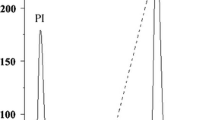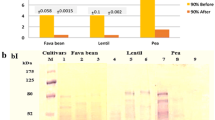Abstract
Moringa oleifera seeds contain a water-soluble lectin [water-soluble M. oleifera lectin (WSMoL)] that has shown coagulant activity. Magnesium ions are able to interfere with the ability of this lectin to bind carbohydrates. In this study, we performed structural characterization of WSMoL and analyzed its effect on the electrical resistance of a kaolin clay suspension in both presence and absence of monosaccharides (N-acetylglucosamine, glucose, or fructose) and magnesium ions. The coagulant activity of WSMoL was monitored by measuring optical density and electrical resistance over a period of 60 min. Native WSMoL had a molecular mass of 60 kDa and exhibited anionic nature (pI 5.5). In sodium dodecyl sulfate–polyacrylamide gel electrophoresis (SDS-PAGE), it appeared as three polypeptide bands of 30, 20, and 10 kDa. WSMoL reduced the optical density and electrical resistance of the kaolin suspension, which suggests that suspended particles are destabilized and that this is followed by formation of complexes. The coagulant activity of lectin decreased in the presence of Mg2+ ions and carbohydrates at concentrations that also inhibited hemagglutinating activity. This was most likely due to conformational changes in lectin structure. Our findings suggest that the coagulant activity of WSMoL is enhanced by lowering of electrical resistance of the medium and is impaired by lectin–carbohydrate and lectin–Mg2+ interactions.





Similar content being viewed by others


References
Makkar, H. P. S., & Becker, K. (1997). Nutrients and anti-quality factors in different morphological parts of the Moringa oleifera tree. Journal of Agricultural Science, 128, 311–322.
Gassenschimdt, U., Jany, K. D., Tauscher, B., & Niebergall, H. (1995). Isolation and characterization of a flocculating protein from Moringa oleifera Lam. Biochimica et Biophysica Acta, 1243, 477–481.
Ndabigengesere, A., Narasiah, K. S., & Talbot, B. G. (1995). Active agents and mechanism of coagulation of turbid waters using Moringa oleifera. Water Research, 29, 703–710.
Okuda, T., Baes, A. U., Nishijima, W., & Okada, M. (2001). Isolation and characterization of coagulant extracted from Moringa oleifera seed by salt solution. Water Research, 35, 405–410.
Ghebremichael, K. A., Gunaratna, K. R., Henriksson, H., Brumer, H., & Dalhammar, G. (2005). A simple purification and activity assay of the coagulant protein from Moringa oleifera seed. Water Research, 39, 2338–2344.
Santos, A. F. S., Luz, L. A., Argolo, A. C. C., Teixeira, J. A., Paiva, P. M. G., & Coelho, L. C. B. B. (2009). Isolation of a seed coagulant Moringa oleifera lectin. Process Biochemistry, 44, 504–508.
Ferreira, R. S., Napoleão, T. H., Santos, A. F. S., Sá, R. A., Carneiro-da-Cunha, M. G., Morais, M. M. C., Silva-Lucca, R. A., Oliva, M. L. V., Coelho, L. C. B. B., & Paiva, P. M. G. (2011). Coagulant and antibacterial activities of the water-soluble seed lectin from Moringa oleifera. Letters in Applied Microbiology, 53, 186–192.
Yu, J. F., Wang, D. S., Yan, M. Q., Ye, C., Yang, M., & Ge, X. (2007). Optimized coagulation of high alkalinity, low temperature and particle water: pH adjustment and polyelectrolytes as coagulant aids. Environmental Monitoring and Assessment, 131, 377–386.
Cubas, A. L. Y. (1989). Floculação em meio granular expandido. Master’s thesis: Universidade Federal de Santa Catarina, Florianópolis, Brazil.
Di Bernardo, L., & Dantas, A. D. B. (2005). Métodos e técnicas de tratamento de água. São Paulo, Brazil: Rima.
Ferreira Filho, S. S., & Lage Filho, F. A. (1996). Comportamento químico do alumínio e do ferro em meio aquoso e implicações no tratamento de água. Sanare – Revista Técnica da Sanepar, 6, 50–58.
Hassemer, M. E. N. (2000). Tratamento de efluente têxtil—processo físico-químico com ozônio e floculação em meio granular. Master’s thesis: Universidade Federal de Santa Catarina, Florianópolis, Brazil.
Santos, A. F. S., Luz, L. A., Napoleão, T. H., Paiva, P. M. G., & Coelho, L. C. B. B. (2013). Coagulation, flocculation, agglutination and hemagglutination: similar properties? In J. C. Taylor (Ed.), Advances in Chemistry Research vol. 20 (pp. 51–70). New York: Nova Science Publishers Inc..
Duan, J., & Gregory, J. (2006). Coagulation by hydrolysing metal salts. Advances in Colloid and Interface Science, 100, 102–475.
Bolto, B., & Gregory, J. (2007). Organic polyelectrolytes in water treatment. Water Research, 41, 2301–2324.
Carvalho, M. J. H. (2008). Uso de coagulantes naturais no processo de obtenção de água potável. Master’s thesis: Universidade Estadual de Maringá, Maringá, Brazil.
Fabris, R., Chow, C. W., & Drikas, M. (2010). Evaluation of chitosan as a natural coagulant for drinking water treatment. Water Science and Technology, 61, 2119–2128.
Hébert, E. (2000). Endogenous lectins as cell surface transducers. Bioscience Reports, 20, 213–237.
Rambaruth, N. D. S., & Dwek, M. V. (2011). Cell surface glycan–lectin interactions in tumor metastasis. Acta Histochemica, 113, 591–600.
Dias, R. O., Machado, L. S., Migliolo, L., & Franco, O. L. (2015). Insights into animal and plant lectins with antimicrobial activities. Molecules, 20, 519–541.
Napoleão, T. H., Santos-Filho, T. G., Pontual, E. V., Ferreira, R. S., Coelho, L. C. B. B., & Paiva, P. M. G. (2013). Affinity matrices of Cratylia mollis seed lectins for isolation of glycoproteins from complex protein mixtures. Applied Biochemistry and Biotechnology, 171, 744–755.
Oliveira, M. D. L., Nogueira, M. L., Correia, M. T. S., Coelho, L. C. B. B., & Andrade, C. A. S. (2012). Detection of dengue virus serotypes on the surface of gold electrode based on Cratylia mollis lectin affinity. Sensors and Actuators B: Chemical, 155, 789–795.
Lino, J. S. L., Oliveira, M. D. L., Melo, C. P., & Andrade, C. A. S. (2014). Impedimetric sensor of bacterial toxins based on mixed (Concanavalin A)/polyaniline films. Colloids and Surfaces B: Biointerfaces, 117, 549–554.
Hemmi, H., Kuno, A., & Hirabayash, J. (2013). NMR structure and dynamics of the C-terminal domain of R-type lectin from the earthworm Lumbricus terrestris. FEBS Journal, 280, 70–82.
Dong, M., Xu, S., Oliveira, C. L. P., Pedersen, J. S., Thiel, S., Besenbacher, F., & Vorup-Jensen, T. (2007). Conformational changes in mannan-binding lectin bound to ligand surfaces. Journal of Immunology, 178, 3016–3022.
Santana, G. M. S., Albuquerque, L. P., Napoleão, T. H., Souza, S. R., Coelho, L. C. B. B., & Paiva, P. M. G. (2012). Electrochemical potential of Microgramma vaccinifolia rhizome lectin. Bioelectrochemistry, 85, 56–60.
Ambrosi, M., Cameron, N. R., & Davis, B. G. (2005). Lectins: tools for the molecular understanding of the glycocode. Organic & Biomolecular Chemistry, 3, 1593–1608.
Coelho, J. S., Santos, N. D. L., Napoleão, T. H., Gomes, F. S., Ferreira, R. S., Zingali, R. B., Coelho, L. C. B. B., Leite, S. P., Navarro, D. M. A. F., & Paiva, P. M. G. (2009). Effect of Moringa oleifera lectin on development and mortality of Aedes aegypti larvae. Chemosphere, 77, 934–938.
Rolim, L. A. D. M. M., Macedo, M. F. S., Sisenando, H. A., Napoleão, T. H., Felzenszwalb, I., Aiub, C. A. F., Coelho, L. C. B. B., Medeiros, S. R. B., & Paiva, P. M. G. (2011). Genotoxicity evaluation of Moringa oleifera seed extract and lectin. Journal of Food Science, 76, T53–T58.
Green, A. A., & Hughes, W. L. (1955). Protein solubility on the basis of solubility in aqueous solutions of salts and organic solvents. In S. Colowick & N. Kaplan (Eds.), Methods in enzymology (pp. 67–90). New York: Academic Press.
Lowry, O. H., Rosebrough, N. J., Farr, A. L., & Randall, R. J. (1951). Protein measurement with the Folin phenol reagent. Journal of Biological Chemistry, 193, 265–275.
Laemmli, U. K. (1970). Cleavage of structural proteins during the assembly of the head of bacteriophage T4. Nature, 227, 680–685.
Paiva, P. M. G., & Coelho, L. C. B. B. (1992). Purification and partial characterization of two lectin isoforms from Cratylia mollis Mart. (camaratu bean). Applied Biochemistry and Biotechnology, 36, 113–118.
Bing, D. H., Weyand, J. G., & Stavinsky, A. B. (1967). Hemagglutination with aldehyde-fixed erythrocytes for assay of antigens and antibodies. Proceedings of the Society for Experimental Biology and Medicine, 124, 1166–1170.
Paiva, P. M. G., Santana, G. M. S., Souza, I. F. A. C., Albuquerque, L. P., Agra-Neto, A. C., Albuquerque, A. C., Luz, L. A., Napoleão, T. H., & Coelho, L. C. B. B. (2011). Effect of lectins from Opuntia ficus indica cladodes and Moringa oleifera seeds on survival of Nasutitermes corniger. International Biodeterioration & Biodegradation, 65, 982–989.
Acknowledgments
The authors express their gratitude to the Conselho Nacional de Desenvolvimento Científico e Tecnológico (CNPq), for research grants and fellowship (L.C.B.B. Coelho, M.D.L. Oliveira, and P.M.G. Paiva), to the Coordenação de Aperfeiçoamento de Pessoal de Nível Superior (CAPES), and to the Fundação de Amparo à Ciência e Tecnologia do Estado de Pernambuco (FACEPE) for research grants. K.S. Moura would like to thank CNPq for graduate scholarship.
Author information
Authors and Affiliations
Corresponding author
Rights and permissions
About this article
Cite this article
de Moura, K.S., da Silva, H.R.C., Dornelles, L.P. et al. Coagulant Activity of Water-Soluble Moringa oleifera Lectin Is Linked to Lowering of Electrical Resistance and Inhibited by Monosaccharides and Magnesium Ions. Appl Biochem Biotechnol 180, 1361–1371 (2016). https://doi.org/10.1007/s12010-016-2172-y
Received:
Accepted:
Published:
Issue Date:
DOI: https://doi.org/10.1007/s12010-016-2172-y


